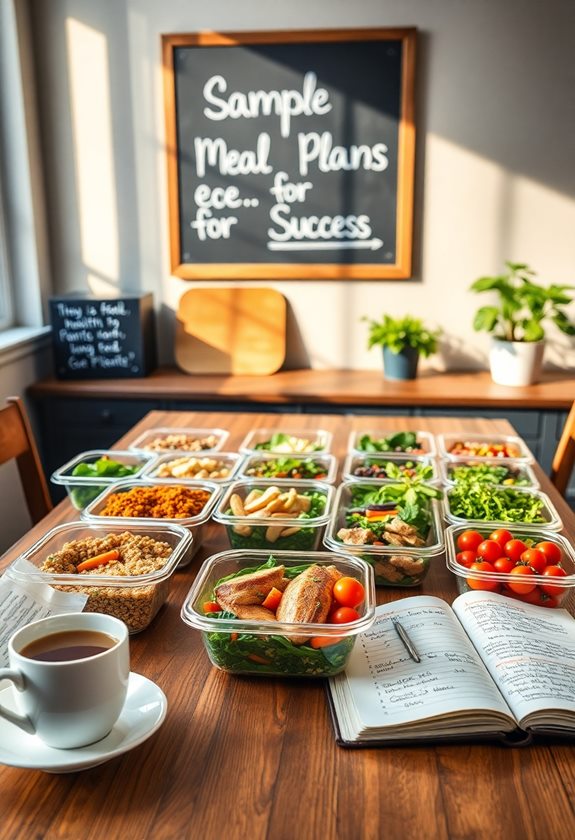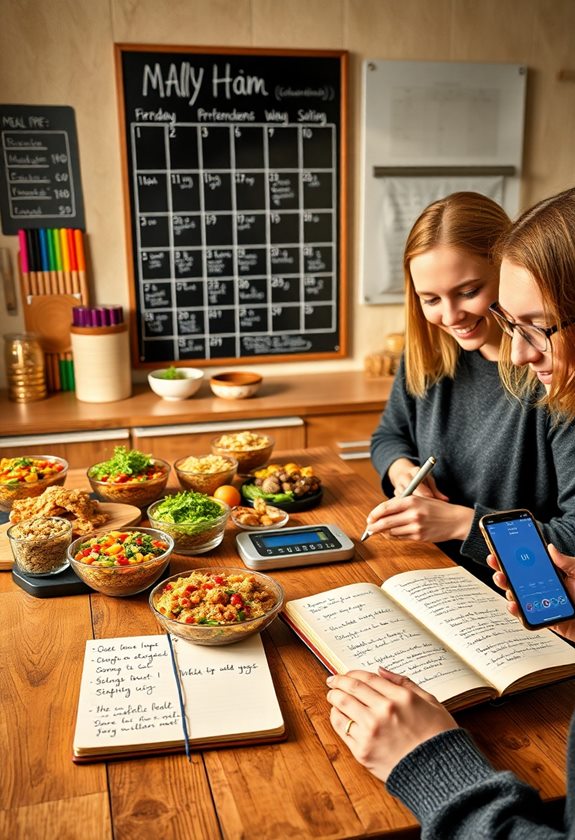You can overcome emotional eating and slim down by planning simple, nutritious meals! Start with whole foods like fresh fruits, veggies, and lean proteins. These foods nourish you and keep cravings at bay. Try oatmeal with berries for breakfast and a salad with grilled chicken for lunch. Remember to snack wisely, like with a small handful of nuts. Have you considered journaling your feelings? It helps recognize your triggers! Eating mindfully, like slowing down and savoring each bite, can make a big difference too. Curious about more tips? There's plenty more to explore on this journey! 🍏🥗
Key Takeaways
- Incorporate whole foods like fruits, veggies, and lean proteins to nourish the body and reduce cravings.
- Plan meals with structure, such as oatmeal for breakfast and mixed greens salad for lunch, to manage emotional eating triggers.
- Practice mindful eating by savoring each bite and limiting distractions to enhance awareness of hunger and fullness cues.
- Stay hydrated throughout the day to help curb emotional eating tendencies and maintain energy levels.
- Keep a food journal to track eating habits and identify emotional triggers for better meal plan adjustments.
Understanding Emotional Eating

When you find yourself reaching for snacks during stressful moments, it's vital to recognize that you're engaging in emotional eating. This behavior often stems from feelings like anxiety, loneliness, or boredom. Have you ever noticed how a sugary treat can lift your mood, even if just for a moment?
Emotional eating isn't about hunger; it's about trying to fill an emotional void. You might think, "Just one cookie won't hurt," but it can lead to a cycle of guilt and more cravings. When stress hits, it's easy to turn to food for comfort, but this can create problems in the long run.
Instead of reaching for that bag of chips, consider other ways to cope. Have you tried going for a walk or journaling your feelings? These actions can help you process what you're going through without relying on food.
Understanding your triggers is key. When you know what leads you to snack mindlessly, you can find healthier ways to handle those tough moments. Remember, it's okay to seek support. You're not alone in this journey! 🌟
Nutritional Foundations for Balance
To create a balanced approach to nutrition, it's essential to focus on whole foods that nourish both your body and mind. Have you ever noticed how certain foods make you feel? When you eat fresh fruits, veggies, whole grains, and lean proteins, your energy levels soar! 🌟 These foods provide essential vitamins and minerals, helping you stay balanced and focused.
Think about it: when you choose processed foods, do you feel satisfied or just want more? Whole foods, on the other hand, fill you up and keep cravings at bay. They're packed with fiber, which aids digestion and helps you feel full longer.
Don't forget to include healthy fats, like avocados and nuts, which boost your mood. Have you tried adding them to your meals? They're delicious and good for your heart!
Hydration is also key. Are you drinking enough water? Staying hydrated can help curb emotional eating.
Sample Meal Plans for Success

Creating a sample meal plan tailored for emotional eating can empower you to make healthier choices throughout your day. By having a guide, you can better tackle those moments when cravings hit. Here's a simple plan to get you started:
- Breakfast: A bowl of oatmeal topped with fresh berries 🍓 and a drizzle of honey. This gives you energy and keeps you full.
- Lunch: A colorful salad with mixed greens, cherry tomatoes, cucumbers, grilled chicken, and a light vinaigrette. It's invigorating and packed with nutrients!
- Snack: A small handful of nuts or a piece of fruit. This helps curb those afternoon munchies without overindulging. 🍉
Mindful Eating Strategies
Understanding your eating habits can greatly enhance your journey toward healthier choices, especially when dealing with emotional eating. Mindful eating is a powerful tool that helps you connect with your food and your feelings. Have you ever eaten a whole bag of chips without even noticing? It happens to many of us.
To practice mindful eating, try slowing down during meals. Focus on each bite—what it tastes like, how it feels. This simple shift can make a big difference. Here's a handy table to help you remember some key strategies:
| Strategy | Action |
|---|---|
| Eat Slowly | Chew each bite thoroughly |
| Limit Distractions | Turn off screens during meals |
| Listen to Your Body | Pause to check if you're full |
| Savor Your Food | Appreciate flavors and textures |
Tracking Progress and Adjustments

As you commence your journey to combat emotional eating, tracking your progress and making necessary adjustments can greatly enhance your effectiveness. You might wonder, how can I know if I'm really making changes? Here's where tracking comes in. By keeping an eye on your habits, you can spot patterns and make shifts that work for you.
Here are three simple ways to track your progress:
- Food Journal 📒: Write down what you eat and how you feel. This helps you see if certain foods trigger emotional eating.
- Weekly Check-Ins 📅: Set aside time each week to review your journal. Are you eating mindfully? Are there any areas you need to change?
- Adjust Meal Plans 🍽️: Based on your check-ins, tweak your meal plans. If you notice you're craving sweets on certain days, maybe add healthier snacks to your plan.

